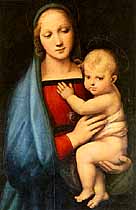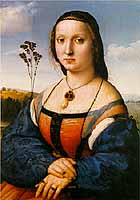
Antique version of the
Inscriptions Room
Contrary to the fears of their Tuscan subjects, the Lorraine family were to be worthy successors to the Medici dynasty and this can also be seen from the way they continued the tradition of collecting art as well as regards their actual management of the artistic heritage, where they not only took a special interest in painting but also in classical sculpture.

Raphael, the
Madonna of Granduke
Pietro Leopoldo, the second of the four Lorraine Grand Dukes who were
to reign over Tuscany, though he was in actual fact the first to live
there (from 1765), rearranged the works of art in the Uffizi
Gallery according to the various schools and in chronological order.
The suppression of convent property was to enrich the grand-ducal
collections at the Uffizi and the Pitti
Palace with many paintings on wood by 14th century masters (the Annunciation
by Simone Martini came from the Cathedral of Siena); meanwhile the Pazzi
collection of self-portraits, the Gaddi collection of drawings and prints,
the Galluzzi and Buccelli collections of Etruscan antiquities and the paintings
that previously belonged to Paolo del Sera and Ignazio Hugford were acquired.

Ferdinando III di Lorena
His son Ferdinando III (Grand Duke from 1791 to 1824) carried out an important exchange of paintings in 1792 with his brother, Emperor Francis II of Austria: this was to bring another 15 masterpeices to Florence including the Flora and the Madonna of the Roses by Titian, the Sacred Allegory by Giovanni Bellini and the Adoration of the Magi by Albrecht Durer. It was not until 1818, at the conclusion of the rule of Napoleon (1799-1815), that Ferdinando was finally able to go ahead with the acquisition of some of the best paintings from the collection of the Marquis Gerini: these included the Rest in Egypt by Van Dyck, the kneeling St. Sebastian by Guercino and the Self-portrait by Rembrandt.

Raphael,
portrait of Agnolo Doni
The last member of the Lorraine family, Leopoldo II (who reigned from 1824
to 1859), was instead responsible for the acquisition of the portraits
of Agnolo and Maddalena Doni by Raphael in March 1826.
After the Unification of Italy, further suppression of the religious orders
was to bring some exceptional works of art to the Florentine Galleries,
among them the Portinari Triptych by Hugo van der Goes (in the church of
the Arcispedale of Santa Maria Nova, whose collection of paintings was
purchased in bulk, until 1897) and much of the collection of the Primitives: Cimabue,
Giotto and their schools, in fact, had hardly been appreciated at all in
earlier centuries and it was not until 1919 that the two famous Maestas
in the Room of the Primitives were to arrive at the Uffizi. The Rucellai
Madonna by Duccio (from Santa Maria Novella)
is an even more recent arrival (1948).

Raphael,
Portrait of Maddalena Doni
In this century however the collection has been further enriched by the conspicuous Contini-Bonacossi donation (which can be seen in Palazzina della Meridiana at the Pitti Palace) and by some new acquisitions: an El Greco, two Chardins and two Goyas. A large number of self-portraits have been donated by painters to add to the exhibition in the Vasari Corridor: Chagall, Siqueiros, Rauschenberg, Guttuso, Annigoni, Carrà, Rosai, Manzù. The latest addition to the collection was Michelangelo Pistoletto's self-portrait in December 1995.
